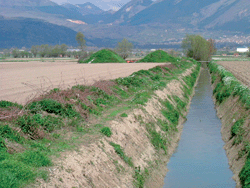In order to evaluate the impact of intensive horticulture on the water resources of the Fucino Plain, one of the most important agricultural settlements of Central Italy, the mobility and persistence in the soil of five commonly used pesticides was investigated by means of multi-lysimeter experiments. The fate of simazine, carbaryl, dicloran, linuron and procymidone was evaluated in the laboratory under experimental conditions simulating as closely as possible both pesticide application and irrigation practices required by the local crops. An efficient extraction procedure followed by chromatographic analysis, allowing the simultaneous determination of the applied chemicals, was used to monitor the pesticide residues in the soil columns as a function of time from application and depth. The experiment, carried out for about 60 days, revealed that soil contamination apparently involves only the surface layer since none of the investigated pesticides was detected at depths greater than 20–30 cm. However, the five pollutants exhibit a quite different behaviour that can be related to their physico–chemical properties.

You have access to this article
 Please wait while we load your content...
Something went wrong. Try again?
Please wait while we load your content...
Something went wrong. Try again?


 Please wait while we load your content...
Please wait while we load your content...